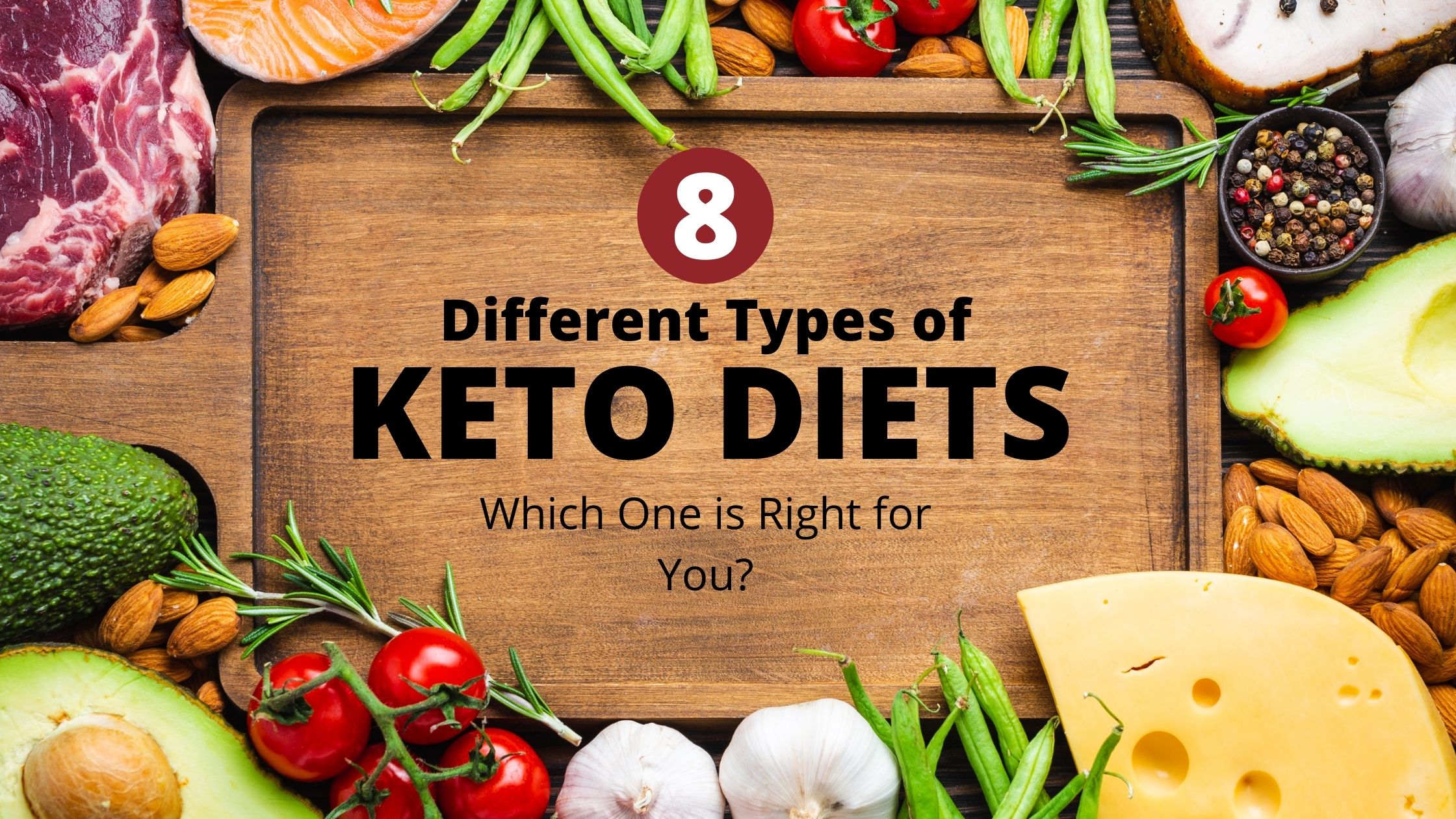8 Different Types of Keto Diets – Which One is Right For You?
For those of you just getting started with keto, you may have run into some confusing, or even conflicting information on how to do keto properly. The reason for this is simple, there are several ways to follow keto successfully, and everyone does it a little differently depending on their individual preferences and goals.
To help clear up some of the confusion, I have outlined some of the primary variations of keto using the terminology that you are most likely to encounter during your search.
As a side note, I did not create any of the terminology associated with these approaches, and my goal here is not to pass judgment. I am simply trying to provide clarity, and help you find the approach that is right for you.
What is Keto?
Keto is a high-fat moderate-protein low-carb diet that has been designed to reprogram the body to utilize fat as its primary fuel source rather than glucose (sugar). As a structured dietary approach, keto was designed to treat people with epilepsy, however it also emulates the diet that humans evolved with for millions of years prior to agriculture.
Benefits of the Ketogenic Diet
While keto has gained popularity largely due to its weight-loss benefits, there are several other reasons to consider adopting a keto lifestyle including;
- More energy
- Increased mental clarity
- Reduced inflammation
- Hormone balance
- Improved sleep
- Lower blood pressure
- Fewer food cravings (greater control over food and appetite)
- Balanced emotional wellness or mood
1) Standard Keto
This is the version most people are referring to when they say they are following a ketogenic diet or lifestyle, and the one that is most commonly associated with the original keto diet designed in the 1920’s as a treatment for epilepsy.
Standard Keto focuses on getting into, and maintaining ketosis by following a specific macronutrient intake in which 75% of daily calories come from fat, 20% come from protein, and 5% come from carbohydrates (carbs).
Most of the other types of keto on this list adhere to this macronutrient intake profile, for the most part, but each one approaches it a little differently.

2) Lazy Keto
There is quite a bit of variation in the manner in which this version is described. The primary focus however, is a daily carb intake of less than 20 grams, with less consideration for fat, protein or calories.
The term “lazy” gives this approach to keto a negative connotation. Diligence is still required to keep carbs below 20 grams per day, there is just less overall tracking being done.
Some people start here because tracking everything is too time consuming, and some people switch to lazy keto after they have reached their weight loss goals, or once they get comfortable estimating the nutritional value of food without tracking it as intensely.
It is generally assumed that people doing lazy keto have no regard for calories, or the nutritional value of food, and while that is sometimes true, it is not always the case. They simply take a more intuitive approach and attempt to simplify the process by focusing exclusively on carbs.
3) Dirty Keto
This is the “if it fits your macros” approach. This variation follows the same macro guidelines as Standard Keto, however there is no emphasis on the quality of the foods selected.
Processed or convenience foods and supplements marketed as “keto-friendly” make up a considerable proportion of this version of the keto diet.
4) Clean Keto
As the name implies, Clean Keto follows the macro guidelines of Standard Keto however, it focuses on whole foods from quality sources (grass-fed, pasture-raised, wild-caught, organic, etc.), and it is free of dairy and processed foods.
This is the version of keto that LiveFitKeto.com is primarily dedicated to, however, we also provide resources and support for those navigating alternate approaches.
5) Carnivore Keto

Animal-based foods consisting of meat, seafood, eggs, bone broth, and dairy make up the entirely of this keto approach. Macros and portion sizes are not generally tracked because carbs are negligible in animal-based foods and no nuts, seeds, or vegetables are consumed.
There tends to be some variation within this diet when it comes to food preparation, and the use of seasonings and/or condiments.
6) Autoimmune Protocol (AIP) Keto
This approach is similar to Clean Keto except it also excludes foods that may cause inflammation in the gut among those with specific food sensitivities. When following this keto approach, alcohol, caffeine, eggs, nuts, seeds, dairy, legumes, yeast, natural sweeteners and nightshades are generally omitted.
7) Cyclical Keto
Cyclical Keto is popular among athletes and/or fitness enthusiasts. Followers of this approach generally adhere to a Standard Keto diet for five or six days each week, and then increase carbs during one or two days.
The higher carb days are often referred to as “refeed days”, and are designed to replenish glucose stores that are depleted during high-intensity training.
For this approach to work properly, it is necessary to become fat-adapted first. This means that a more traditional approach to keto must be followed for four to six weeks before cycling higher carb days back into the diet.
8) Targeted Keto
This approach combines elements of a Standard Keto diet and Cyclical Keto. It also requires individuals to become fat-adapted before reintroducing carbs, however, instead of having entire “refeed” days, higher servings of carbs are only consumed prior to exercise.
Many people that follow this approach suggest that the surge in glucose provides an energy boost that helps propel them through their workouts. The glucose is then utilized during the workout, and the individual is able to get back into ketosis relatively quickly.
Which Type Of Keto Is Right For You?
Determining which approach to keto is the best fit for you will depend heavily on how you currently eat, and what your goals are. It is also ok to change your approach as you go.
For instance, many people begin with a variation of dirty or lazy keto with weight loss in mind and progressively work towards clean keto as they become more comfortable with the diet.
To keep things simple with respect to tracking macros, some people begin with carnivore keto and then gradually incorporate other foods. Once you are fat adapted you may also decide to increase protein or carbs periodically in association with exercise, or to lessen the feeling of restriction.
To be successful on keto you must be consistent in the beginning otherwise your body won’t make the switch to burning fat, you won’t experience the benefits, and you will continue to battle with cravings. Once you become fat adapted, keto becomes much easier, but you will still need to remain diligent.
Tips For Starting Keto
The transition into keto may present a considerable change from how you are currently eating, even if you are already consuming relatively low carbs. As with most diets, being successful on keto requires a significant change in mindset.
There is also less room for error, at least during the first four to six weeks, while you are working towards becoming fat adapted, and to be clear, all types of keto require you to complete the fat adaptation phase.
Keto can seem pretty restrictive at first, especially if you only focus on what you can’t eat. If you are willing to keep an open mind however, you will see that keto can be quite enjoyable.
Tip #1 – Utilizing our free dairy-free keto food list is a great starting point, and many of the foods listed on our site contain links to our recommended sources or brands and where to find the best deals.
Tip #2 – Consider taking a food sensitivity or allergy test. This will allow you to identify potentially problematic foods right from the beginning. Keto as a whole is often falsely blamed for some undesirable side effects, when in reality a food allergy or sensitivity is actually the culprit.
Tip #3 – Embrace new foods. Attempting to create keto versions of your current favorite foods may leave you disappointed and feeling restricted. Don’t cling to old favorites, create new ones.
Tip #4 – Track your macros, at least in the beginning. Use a free tracking tool like MyFitnessPal to monitor your food intake until you are comfortable in your ability to estimate macros and calories.
Tip #5 – Purchase at least one keto cookbook. Our top three favorite dairy-free keto cookbooks offer more than just recipes. They will also help you prepare your kitchen and pantry for success, and introduce you to ingredients and food preparation techniques that will make transitioning into keto much easier.
What keto approach do you follow? Do you have any tips for starting keto? Please consider sharing your experience by commenting below in order to help others living a fit keto lifestyle.
Thank you for visiting LiveFitKeto.com. Check back often for new content or subscribe to our newsletter to receive updates on new articles, and if you have found this information helpful, please don’t hesitate to share.







